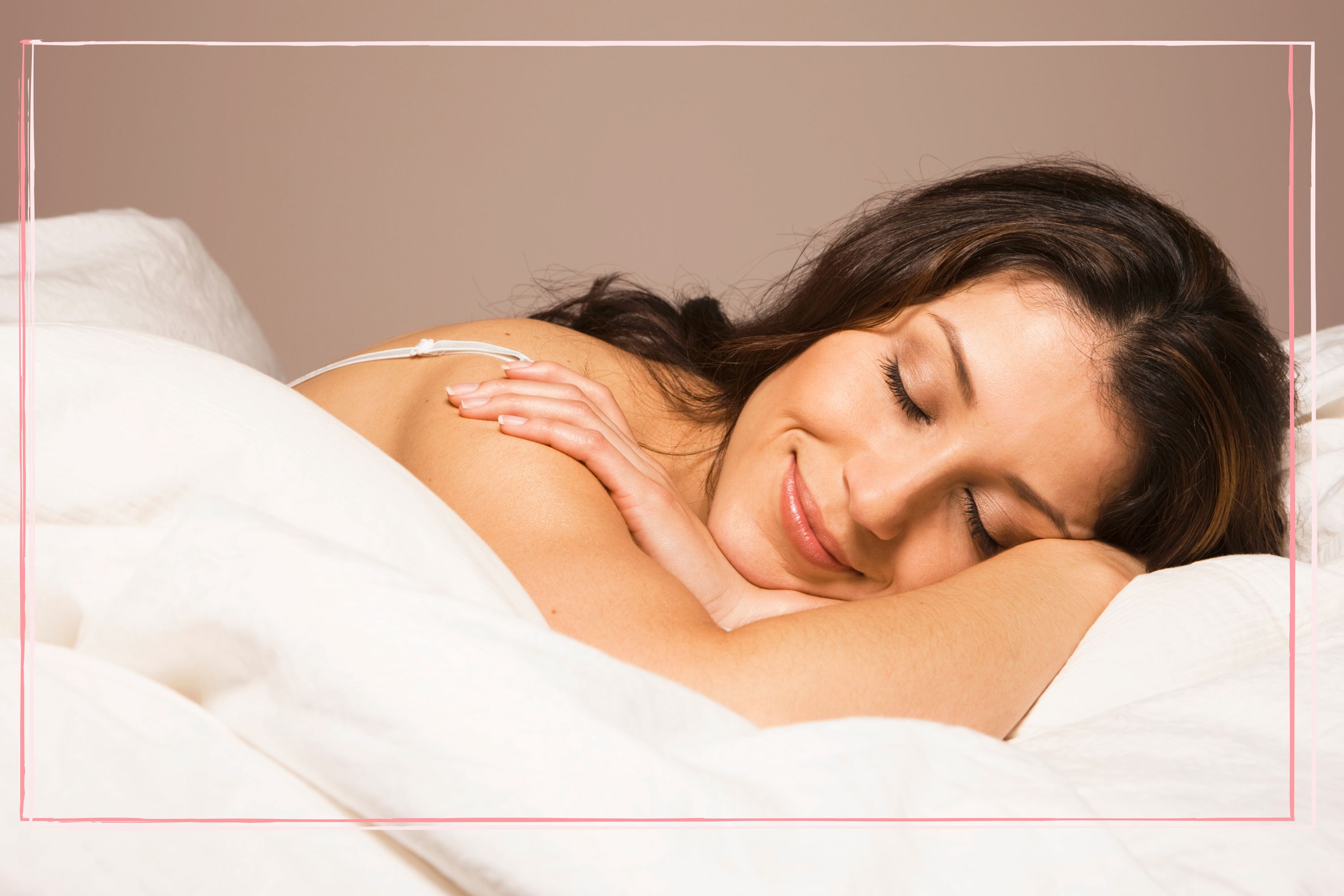What sleeping position is best? How to choose the best sleeping position according to the experts
We asked our experts 'What sleeping position is best?' and how to increase your chances of a peaceful slumber


Whether pain is keeping you up at night or you're struggling to nod off during your pregnancy, you might be asking yourself, 'What sleeping position is best?' and 'How much deep sleep do you need?'
Not only can a poor night's rest leave you feeling grouchy, but according to the Sleep Foundation, sleep deprivation can lead to a variety of health problems such as diabetes, high blood pressure and a weakened immune system. This is why sleep is important.
"The best sleeping position is a very personal thing and predominantly should be comfortable, therefore allowing a good period of undisturbed sleep," says Gregory Davis, Physiotherapy Consultant and Director at The Medical, Bristol. "Whilst you are sleeping your body should be working hard repairing and recovering, so good quality sleep is key and the last thing you want is to wake up with more discomfort than before you nodded off." Want to finally put an end to those sleepless nights? Here, our experts explain how to find the best sleeping position to suit your needs so you can get those all-important ZZZs.
What sleeping position is best?
The best sleeping position is largely down to what makes you feel comfortable and this can depend on a variety of factors, such as managing pain, being pregnant or even common complaints that lead to a lack of sleep, such as snoring.
"From the perspective of a physiotherapist, it is important to keep your spine and neck aligned and supported; as spending 6-10 hours doing one thing, even sleeping, can cause your body to adapt in good or bad ways," says Gregory.

"The ”optimal” sleeping position according to most literature and what I would advise is left-sided sleeping, with a pillow that allows a neutral spine position," he adds. This will not only help with many aches and pains throughout the body, but may help with breathing, reflux and pregnancy. It might also be beneficial for those who are wondering how to stop snoring. However, there are still plenty of benefits to other sleeping positions – the most important thing is finding one which suits your needs and allows you to both nod off and wake up, without pain and discomfort.
Choosing the best sleeping position
1. The best sleeping position for back pain
The best sleeping position for back pain is one that aligns the spine – and sleeping on your back is most effective for this. However, there are moderations you can make to your usual sleeping position if you find this difficult.
Parenting advice, hot topics, best buys and family finance tips delivered straight to your inbox.
According to the International Association for the Study of Pain , around 7.5% of the global population experience lower back pain, and the Sleep Foundation points out that the link between poor sleep and back pain is a two-way relationship. Back pain makes it difficult to get comfortable enough to fall – and stay – asleep, while poor sleep can affect our body's ability to heal, increase our sensitivity to pain and disrupt the chemicals in our brain that are responsible for our perception of pain.
“Lying on your back, as difficult as this is for most of us, is the best sleeping position for keeping your back straight and reducing the risk of back pain as well as helping to manage it, particularly lower back pain," says physiotherapist, Sammy Margo from Mind Your Back UK. Placing a pillow beneath your knees can also help keep your spine neutral and take pressure off your lower back.
Can't nod off in this position? "Sleeping on your side with a pillow between the knees can have a similar effect. For extra support, you can also place a pillow behind your back," adds Gregory. "As you age, sleeping on your back can become more difficult as the natural flexibility of your spine will decrease. This is when sleeping on your side with a pillow for support will be most useful for you."

2. The best sleeping position for sciatica
“Sleeping on your back is also the best position for sciatica. The pain comes from the sciatic nerve (which is in the lower back and lumbar discs), so it’s important to reduce the pressure in this area," says Sammy.
"Lie on your back then place pillows (as many as you find comfortable) under your knees. If you find it difficult to sleep like this place an extra pillow at the side of your back, under each of your elbows and one under your neck," she says.
Try to avoid sleeping on your stomach if you can. This is because it flattens the spine’s natural curve and can add unnecessary strain to the muscles and joints. Sleeping with a body pillow can help prevent you from rolling over in your sleep.
3. The best sleeping position for pregnancy
The safest sleeping position during pregnancy is on either your right or left side. "This will not only relieve pressure because of you ever-growing bump but will also allow efficient blood flow to your liver, kidney, heart, and around both of your bodies (that’s yours and your foetus)," says Gregory.
The Midland and North of England Stillbirth Study (MiNESS), which looked at the sleeping habits of 400 women who had a stillbirth at or after 28 weeks of gestation, found that those who slept on their back during the third trimester, had a 2.3-fold increased risk of stillbirth compared to those who slept on their side.
The exact cause for this isn't known but researchers suggest this is due to the combined weight of the baby and uterus (womb) putting pressure on the main blood vessels that supply the uterus, which can restrict blood flow/oxygen to the baby. Sleeping on your side is advised for going to sleep at night and daytime naps. Don't worry if you wake up on your back – just roll over onto your side.

4. The best sleeping position for neck pain
The best sleeping positions for your neck are on your back or your side. "I recommend the back in the first instance. It’s important to make sure to use a pillow that supports the curvature of your neck and a flatter pillow to cushion your head," says Sammy.
"Sleeping on your side is the second best position for neck pain but use a thicker pillow under your neck so that neck aligns with your head. This will reduce any strain on your neck and keep your spine straight.”
Using a supportive pillow can also help you get a comfortable night's sleep. Gregory recommends the Groove Pillow. "It includes a contoured dip that supports the cervical (neck) area that helps facilitate neutral spinal alignment by guiding your upper body into a comfortable sleeping position whether you lie on your back or are a side sleeper," he says.
The Groove memory foam pillow eliminates neck and upper back pain and stiffness by correcting your posture while you sleep.
5. The best sleeping position for shoulder pain
Whether a recent injury or chronic shoulder pain is the reason you can't sleep, it probably goes without saying that it's recommended that you avoid sleeping on the side where you have the pain.
"I regularly treat people with shoulder pain and the common theme is that sleeping on their side is a no go, even though the side sleeping itself is not the cause, but something that aggravates the issue," says Gregory. "Many front sleepers can suffer with shoulder pain as a result of their sleeping position as it puts pressure on the tendons that work to stabilise the shoulder. "
When suffering with shoulder pain, to fix your sleep schedule, you should either try sleeping on the other side to relieve pressure, or if you are suffering in both shoulders, back sleeping will be the way to go. "You should also try stretches, icing and if the problem persists, speak to a physiotherapist or medical professional," adds Gregory.
6. The best sleeping position for breathing problems
If you suffer from breathing problems such as sleep apnoea then you need to sleep in a position that elevates your head and makes it easier to breathe.
Martin Seeley, sleep Expert and CEO of Mattresss Next Day suggests two ways you should sleep which should help to make breathing easier and help you to feel more comfortable:
- If you are a side sleeper, you should place a pillow between your legs and also add a pillow or two under your head to keep it elevated.
- Back sleepers should lie straight, and keep their head elevated with pillows and knees bent, with a pillow placed under the knees.
"The reason for the pillows under the knees is that it helps to open up your airways by keeping your posture more aligned," he says.
Want to read more like this? Find out What is the Military Sleep Method and 'How much deep sleep you need' - and how much sleep do teenagers need too - to boost the quality of your slumber further!
Video of the week

Gregory is an experienced physiotherapist who has spent years working with all members of the public in private and NHS settings. He has worked with professional athletes and office workers, children, pregnant women, and the ageing population with all sorts of mechanical issues. His speciality is spinal treatments, ergonomics, and gait analysis for orthotic prescription.

Sammy from Mind Your Back has been a chartered physiotherapist for 32 years and has built up her clinic over the past 27 years. She trained as a chartered physiotherapist and did a Masters in Physiotherapy (MSc) at University College and Middlesex Hospital.
She is also a qualified Aerobics and Pilates instructor and incorporates this 'balanced body' approach into her physiotherapy treatments. She is a a member of the Manipulative Association of Chartered Physiotherapists (MACP).

Having established and managed multiple bed stores throughout the South East in the 1980s, Martin has a long history in the mattress and bed industry. In the early 2000s, Martin and his Dad branched out into online bed retail, where MattressNextDay was born. When his Dad retired, Martin took over as CEO, overseeing and expanding the business in areas such as brand development, website traffic growth, and importantly building strong relationships with suppliers to ensure that customers get the best quality and price.
Rose Goodman joined Future Publishing in 2020 and writes across Goodto.com, Woman & Home, Woman, Chat and Woman’s Own magazines. Prior to pursuing her career as a writer, Rose obtained a degree in psychology and went on to work in adult mental health for five years at Addenbrooke’s Hospital, Cambridge, specialising in eating disorders. She is fully trained in first aid, medical emergency response and motivational interviewing – a directive, patient-style counselling approach to address ambivalence in recovery. She graduated with a MA in creative writing from the University of Brighton in 2017. In her spare time she enjoys writing poetry and attending literary events, and offers weekly support to those living with homelessness. Rose has a passion for raising awareness around mental illness and the importance of prioritising our wellbeing.

